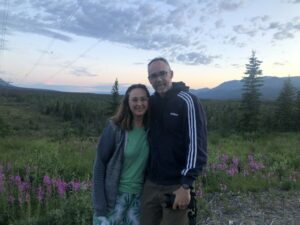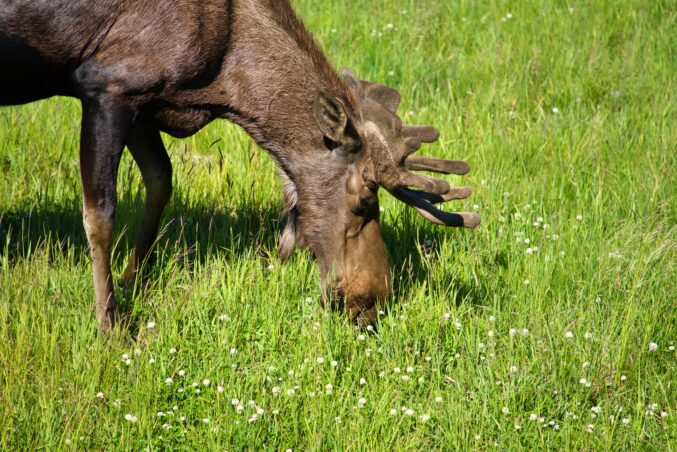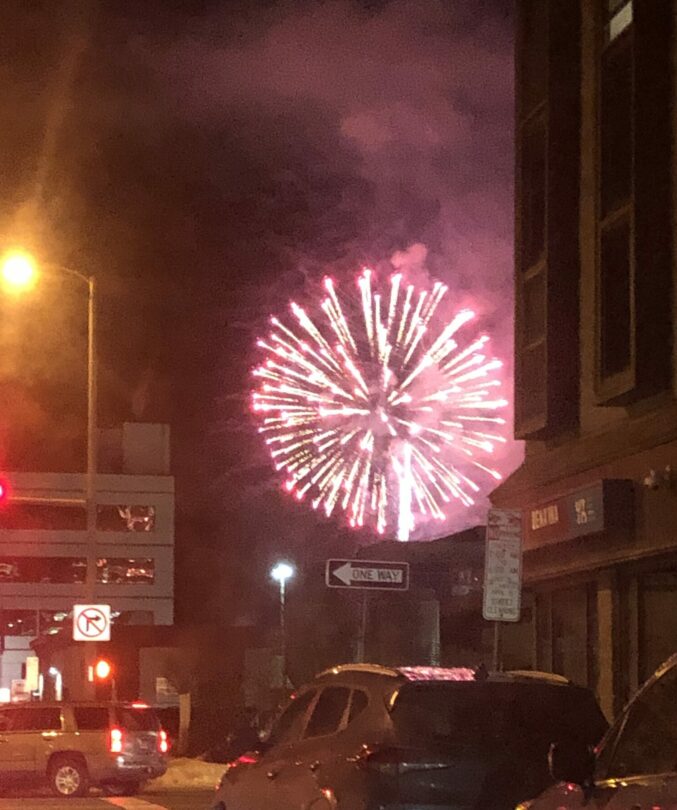
Niklas Wikstrand pulling out of Takotna in the dark. Photo Credit: Iditarod
Last year, as a finalist for the position of 2023 Teacher on the Trail, I visited Alaska from February 26 through March 7, 2022. I fielded many questions about the experience, but one that always seemed to crop up was, “How much daylight did you have? Because it must have been pretty dark up there in the winter!” The answer is, “It wasn’t really that dark. There was quite a bit of daylight- by the time I left on March 7th the sun was up for 11 hours!” The amount of daylight close to the Arctic circle is fascinating for those of us in the lower 48, but I realized that we focus on the extremes – like Utqiagvik, Alaska, a town north of the Arctic circle, that doesn’t see the sun for 65 days from November to late January, or witnessing the sun still up in the sky at midnight over Denali in the summer. Yes, both happen, but they aren’t reflective of the entire experience of night and day in Alaska.

Me and my husband, Kevin, at 12:08am enjoying the Midnight Sun in early July with Denali in the background! Photo Credit: J. Westrich
There is opportunity in misconceptions. It is a chance to teach and learn about the science and math behind the amount of daylight at a given time in the year and to break down inaccurate ideas through research and data. Teaching about changes in daylight depends greatly on the grade level, content area, and learning target for the lesson. Scaffolding this topic provides options that are adaptable to your grade level and classroom instruction.
Initially, students need to understand the concept of changes in daylight throughout the year. For my young learners this works well when integrated into the study of change of seasons. As a science lesson we identify the characteristics of each season, and introduce key times of the year related to light – solstice and equinox. For the complete lesson plan click HERE. Older grades can dive into the scientific aspects of the Earth’s tilt, rotation, and orbit: how is this responsible for the changes in daylight and seasons?

Still kayaking under blue skies at 8pm on a summer Alaska night. Photo Credit: J. Westrich
Elementary students learn how to tell and measure time, a skill essential for developing mathematical understanding. Combine this with reading a chart – another math skill – to collect data about the changes in daylight. Now you have a lesson that combines skill application and Iditarod themed content. Have students read the chart on timeanddate.com for Anchorage, Alaska (or Nome, or Denali) to collect data for sunrise and sunset at different times of the year. The chart does have a column that calculates hours of daylight – which you can use to support learning goals around accurate chart reading. For more advanced students I’d keep this column hidden and have students calculate the hours of daylight between sunrise and sunset themselves! I recommend using the Winter/Summer solstice and Fall/Spring equinox. Repeat this activity for your geographic location. Then, compare and contrast your findings!

How does the amount of daylight impact plants and animals? Photo Credit: J. Westrich
Take it to another level in a high school biology class and investigate plant or animal species and how the change in daylight impacts adaptations, food sources, or growing season. In a high school math class use the data to create a trigonometric function to model the hours of daylight, hours of night, or sunset/sunrise times. Students will see how the amplitude changes based on different latitude locations! Assign each student a unique location, or make it self-directed and let each student choose a geographic location that is interesting to them. (Collaborate with Social Studies or ELA on a country research project!) These examples provide an opportunity for authentic learning – not just rote memorization of a formula, but understanding how it is applied in the real world.

Fireworks bursting over downtown Anchorage! Photo Credit: J.Westrich
Speaking of the real world, on my very first night in Anchorage I picked up my rental car and headed downtown. As I came off the highway, directly in front of me, fireworks burst in the night sky. It was part of the Fur Rendezvous Festival, but I felt like it was just for me, welcoming and cheering me on at the start of a great adventure. I learned later that New Year’s Eve is the big time for fireworks in Alaska. Can you and your students figure out why? I love a good patriotic display on a hot July night, but with some newfound knowledge and understanding your students will be able to explain just why that won’t work in Alaska!
Library Learnings: Read The Explosive Story of Fireworks by Kama Einhorn, part of the “History of Fun Stuff” series, to introduce why our favorite 4th of July tradition in the lower 48 is a winter-only way to celebrate in Alaska! For an early childhood introduction to this topic check out the video Blippi Learns About Fireworks


